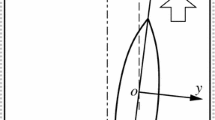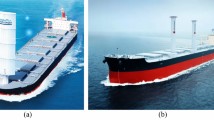Abstract
This paper presents a method to efficiently calculate steady sailing conditions such as check helm, speed drop, hull drift angle, etc. of a ship moving in parallel to a bank wall under steady wind, together with the course stability at the equilibrium condition. Using this method, this study investigates the bank effect on the steady sailing condition and the course stability of a pure car carrier in steady wind and it evaluates the limiting wind condition for safe navigation (maneuvering limit). In case of head wind, a significant speed drop appears. In case of oblique head wind from the port side, the hull drift angle increases significantly and there is a distinct possibility that the ship touches the bank wall. In case of oblique following wind from the port side, the check helm increases significantly, because the wind force is added to the bank suction force. This becomes critical when the ship moves closer to the bank and in more shallow water areas, and the maneuvering limit level becomes more severe. The present method is a useful tool for measuring the maneuvering limit of a ship moving in close proximity to the bank under steady wind.













Similar content being viewed by others
Abbreviations
- CS:
-
Course stability
- MCR:
-
Maximum continuous rating (of main engine)
- MMG:
-
Maneuvering modeling group
- NOR:
-
Normal rating
- PCC:
-
Pure car carrier
- SSC:
-
Steady sailing condition
- \(\alpha _z\) :
-
Vertical acting point of the lateral added mass component \(m_y\)
- \(\beta\) :
-
Hull drift angle at midship
- \(\overline{{\gamma }_R}\) :
-
Averaged flow straightening coefficient
- \(\delta\) :
-
Rudder angle
- \(\eta\) :
-
Lateral deviation of the ship centerline at midship position from \(x_0\)-axis
- \(\theta _A\) :
-
Relative wind direction
- \(\theta _W\) :
-
Absolute wind direction
- \(\rho\) :
-
Water density
- \(\rho _a\) :
-
Air density
- \(\phi\) :
-
Roll angle
- \(\psi\) :
-
Ship heading
- \(\nabla\) :
-
Displacement volume of the ship
- \(A_X\), \(A_Y\) :
-
Front and side profile areas of the ship in air, respectively
- \(A_R\) :
-
Rudder profile area
- \(a_H\) :
-
Rudder force increase factor
- B :
-
Ship breadth
- \(C_b\) :
-
Block coefficient
- \(C_{XA}\), \(C_{YA}\), \(C_{NA}\), \(C_{KA}\) :
-
Aerodynamic force coefficients with respect to surge force, lateral force, yaw moment and roll moment, respectively
- \(D_P\) :
-
Propeller diameter
- d :
-
Ship draft
- \(F_N\) :
-
Rudder normal force
- \(\overline{GM}\) :
-
Metacentric height
- \(G_1, G_2\) :
-
Control gains for autopilot
- g :
-
Gravity acceleration
- \(H_R\) :
-
Rudder span length
- h :
-
Water depth
- \(I_{xx}, I_{zz}\) :
-
Moment of inertia of the ship around \(x-\) and \(z-\)axes, respectively
- \(J_{xx}, J_{zz}\) :
-
Added moment of inertia around \(x-\) and \(z-\)axes, respectively
- \(\overline{KM}\) :
-
Metacenter height above baseline
- \(K_{\dot{\phi }}\), \(K_{\dot{\phi }\dot{\phi }}\) :
-
Roll damping coefficients
- \(k_{xx}\) :
-
Radius of roll gyration including added moment of inertia with respect to the roll
- L :
-
Ship length between perpendiculars
- m :
-
Ship’s mass
- \(m_x\), \(m_y\) :
-
Added masses of the x-axis direction and y-axis direction, respectively
- \(N_{MCR}\) :
-
Propeller revolution at MCR
- \(N_P\) :
-
Propeller revolution
- \(N_S\) :
-
Propeller revolution at \(P_S\)
- \(N_v'\), \(N_r'\), \(N_{\phi }'\), \(N_{vvv}'\), etc.:
-
Hydrodynamic derivatives with respect to yaw moment
- \(o-xyz\) :
-
Horizontal body-fixed coordinate system considering the origin at midship
- \(o_0-x_0y_0z_0\) :
-
Space-fixed coordinate system
- \(P_{MCR}\) :
-
Engine power at MCR
- \(P_S\) :
-
Engine power at NOR with \(15\%\) sea margin
- \(Q_{EMAX}\) :
-
Maximum propeller torque of the main engines
- \(R_0\) :
-
Ship resistance in straight moving
- r :
-
Yaw rate
- s :
-
Distance from the bank toe to ship side
- T :
-
Propeller thrust
- t :
-
Time
- \(t_P\) :
-
Thrust deduction factor
- \(t_R\) :
-
Steering resistance deduction factor
- U :
-
Resultant speed (\(=\sqrt{u^2+v_m^2}\))
- \(U_W\) :
-
Absolute wind velocity
- u, v :
-
Surge velocity and lateral velocity at the center of gravity,
respectively
- \(V_A\) :
-
Relative wind velocity
- \(V_S\) :
-
Design speed of the ship
- \(v_m\) :
-
Lateral velocity at midship
- W :
-
Distance from the bank toe at the sea bottom to ship center line
- X, Y, N, K :
-
Surge force, lateral force, yaw moment, and roll moment with the exception of added mass components, respectively
- \(X_A\), \(Y_A\), \(N_A\), \(K_A\) :
-
Surge force, lateral force, yaw moment, and roll moment due to wind
- \(X_H\), \(Y_H\), \(N_H\) :
-
Surge force, lateral force, and yaw moment acting on the ship hull with the exception of added mass components, respectively
- \(X_P\) :
-
Surge force due to the propeller
- \(X_R\), \(Y_R\), \(N_R\) :
-
Surge force, lateral force, and yaw moment by steering, respectively
- \(X_{vv}'\), \(X_{rr}'\), \(X_{\phi \phi }'\), \(X_{vr}'\) etc.:
-
Hydrodynamic derivatives with respect to surge force
- \(x_G\) :
-
Longitudinal coordinate of the center of gravity of the ship
- \(x_H\) :
-
Longitudinal coordinate of the acting point of the additional lateral force component induced by steering
- \(x_R\) :
-
Longitudinal coordinate of the rudder position (\(=-0.5L\))
- \(Y_{H0}\) :
-
Hull lateral force excluding bank effect
- \(Y_{H\eta }\) :
-
Hull lateral force components including bank effect
- \(Y_v'\), \(Y_r'\), \(Y_{\phi }'\), \(Y_{vvv}'\) etc.:
-
Hydrodynamic derivatives with respect to lateral force
- \(z_G\) :
-
Vertical coordinate of the center of gravity of the ship
- \(z_H\) :
-
Vertical coordinate of the acting point of the hull lateral force
- \(z_{H0}\) :
-
Vertical coordinate of the acting point of hull lateral force components excluding bank effect
- \(z_{H\eta }\) :
-
Vertical coordinate of the acting point of hull lateral force components including bank effect
- \(z_R\) :
-
Vertical coordinate of the acting point of the rudder force
- subscript 0:
-
Implies a steady term
- substituting \({\varDelta }\) :
-
Implies an unsteady term
References
Fujino M (1968) Experimental studies on ship manoeuvrablity in restricted waters—Part I. Int Shipbuild Prog 15(168):279–301
Fujino M (1970) Experimental studies on ship manoeuvrablity in restricted waters—Part II. Int Shipbuild Prog 17(186):45–65
Eda H (1971) Directional stability and control of ships in restricted channels. Trans SNAME 79:71–116
Sano M, Yasukawa H, Hata H (2014) Directional stability of a ship in close proximity to channel wall. J Mar Sci Technol 19(4):376–393
Yasukawa H (2019) Maneuvering hydrodynamic derivatives and course stability of a ship close to bank. Ocean Eng 188(1–10):106149
Yasukawa H, Sano M, Amii H (2013) Wind effect on directional stability of a ship moving in a channel. J Jpn Soc Nav Archit Ocean Eng 18:45–53 (in Japanese)
Yasukawa H, Sakuno R (2020) Application of the MMG-method for prediction of steady sailing condition and course stability of a ship under external disturbances. J Mar Sci Technol 25(1):196–220
Hamamoto M, Kim Y (1993) A new coordinate system and the equations describing manoeuvring motion of a ship in waves. J Soc Nav Archit Jpn 173:209–220 (in Japanese)
Yasukawa H, Sakuno R, Yoshimura Y (2019) Practical maneuvering simulation method of ships considering the roll-coupling effect. J Mar Sci Technol 24:1280–1296
Yasukawa H, Yoshimura Y (2015) Introduction of MMG standard method for ship maneuvering predictions. J Mar Sci Technol 20(1):37–52
Yoshimura Y, Nagashima J (1985) Estimation of the manoeuvring behavior of ship in uniform wind. J Soc Nav Archit Jpn 158:125–136 (in Japanese)
Yoshimura Y (1986) Mathematical model for the manoeuvring ship motion in shallow water. J Kansai Soc Nav Archit Jpn 200:41–51 (in Japanese)
Newman JN (1977) Marine hydrodynamics. The MIT Press, Cambridge, pp 132–140
Newman JN (1992) The green function for potential flow in a rectangular channel. J Eng Math 26:51–59
Yasukawa H, Kawamura S, Tanaka S, Sano M (2009) Evaluation of ship-bank and ship-ship interaction forces using a 3D panel method. Proc. Int. Conf. on Ship Manoeuvring in Shallow and Confined Water: Bank Effects, Antwerp, Belgium, pp 127–133
Fujiwara T, Ueno M, Nimura T (1998) Estimation of wind forces and moments acting on ships. J Soc Nav Archit Jpn 183:77–90 (in Japanese)
Spyrou KJ, Tigkas I, Chatzis A (2007) Dynamics of a ship steering in wind revisited. J Ship Res 51(2):160–173
Yasukawa H, Hirono T, Nakayama Y, Koh KK (2012) Course stability and yaw motion of a ship in steady wind. J Mar Sci Technol 17(3):291–304
Acknowledgements
This study was supported by the JSPS KAKENHI Grant Number JP26249135. The author expresses his sincere gratitude to Mr. R. Sakuno for his assistance with the captive model tests in shallow water.
Author information
Authors and Affiliations
Corresponding author
Additional information
Publisher's Note
Springer Nature remains neutral with regard to jurisdictional claims in published maps and institutional affiliations.
About this article
Cite this article
Yasukawa, H. Steady sailing performance of a ship in the proximity to the bank under windy conditions. J Mar Sci Technol 25, 1246–1265 (2020). https://doi.org/10.1007/s00773-020-00712-x
Received:
Accepted:
Published:
Issue Date:
DOI: https://doi.org/10.1007/s00773-020-00712-x




